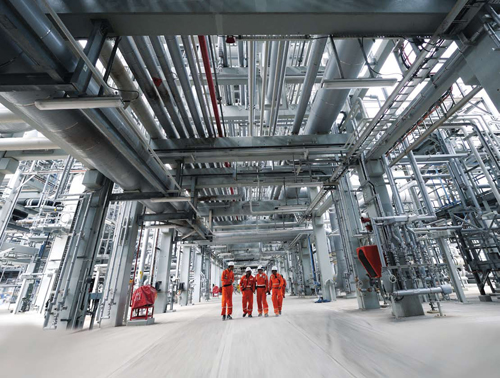
Qatar possesses what is the third-largest reserve of all known natural gas on the planet, behind only Russia and Iran. According to figures taken in January 2011 reserves in the state were measured at approximately 896 trillion cubic feet. This means that it contains as much as 14 percent of the world’s known natural gas.
Established in 1984, and headquartered in Doha, Qatargas is recognised today as being the largest LNG producing company in the world, with an annual LNG production capacity of 42 million tonnes per annum (MTA).
This immense production capacity is delivered to customers around the world from the company’s world-class facilities and assets - Qatargas 1, Qatargas 2, Qatargas 3 and Qatargas 4. From these assets the company carries its output on seven LNG trains, four of which are officially the largest in the world, each boasting a production capacity of 7.8 MTA.
Since the establishment of Qatargas 1, the company has completed a successful expansion programme that has included the development of the Qatargas 2; Qatargas 3 and Qatargas 4 projects, its Laffan Refinery, a dedicated fleet of ships, a regasification terminal, and the establishment of liaison offices in Japan and China.
Qatargas’ offshore operations can be found occurring some 80 kilometres northeast of Qatar’s mainland. For its Qatargas 1 project the company has drilled a total of 22 production wells which now supply 1,600 million standard cubic feet of dry natural gas per day from the field’s reservoir to existing onshore trains.
Meanwhile at Qatargas 2 the company has drilled thirty wells, from which 2.9 billion standard cubic feet of wet natural gas per day is transferred to Trains 4 and 5 onshore. Furthermore, Qatargas 3 and Qatargas 4 supply 1.4 billion standard cubic feet of wet natural gas per day between them, each to onshore Trains 6 and 7 respectively. In total 33 wells are shared between these two particular ventures.
At the very heart of Qatargas’ offshore operations is its North Field Bravo offshore complex. Commissioned in 1996 the complex’s main facilities include two production platforms, three wellhead platforms and one remote platform station around five kilometres away. It is from this complex that three of Qatargas 2’s installed platforms are remotely operation, while the three platforms shared between Qatargas 3 and Qatargas 4 are operated from the company’s onshore control room.
Qatargas’ onshore operations on the other hand occupy a site within the Ras Laffan industrial city on a plot of land 3.9 square kilometres in area. The original plant consisted of only three trains to process the natural gas from offshore. The capacity of these first three trains was a combined ten MTA of LNG. It wasn’t until that 2009 the Qatargas’ Trains 4 and 5, each with a capacity of 7.8 MTA started operating, bringing the combined production capacity of Qatargas to 26 MTA and ushering in a new era of ‘mega-trains’ as they have come to be known. This was followed by the arrival of Train 6 in late 2010 and finally Train 7 in early 2011.
It is Qatargas’ belief that its commitment to excellence is what has enabled it to become pioneers in the global LNG industry and helped it to create steady growth, advance operational excellence and establish the highest levels of safety and environmental performance.
While acknowledging the strides it has made, one thing that Qatargas places at the very heart of its priorities is its corporate citizenship. Indeed the company strongly believes that as a global leader in the global energy industry, it does not operate in isolation. On the contrary, it believes that Qatargas is intrinsically linked with the communities and environments in which it operates, wherever they may be around the world.
Keenly aware that this link brings it opportunities as well as responsibilities, Qatargas is committed to operating in ways that reflect its core values, where it looks to create partnerships with the community based on trust, ingenuity, innovation and collaboration. That is why as a global leader in the energy sector it has chosen to align social investments with its business objectives, whilst at the same time working with dedication to create and maintain partnerships that promote the long-term economic, environmental, and social value of the communities in which we operate.
To this end the company boasts a comprehensive Corporate Social Responsibility (CSR) programme focused on long-term, sustainable social development. In addition to this programme Qatargas is keen to display the fact that it strives to adhere to and maintain the highest standards of energy use, responsible energy management and energy conservation, while also upholding a strong commitment to care and the protection of the environment.
As the company looks to build further still on its accomplishments it has set out a visit for itself whereby it intends to become recognised across the globe as the world’s premier LNG company, one that is known for people, innovation, operating excellence, environmental responsibility and corporate citizenship, by 2015.
On top of this the company will endeavour to set an industry standard for safety performance, customer satisfaction, efficient and reliable operations and financial performance, and through its high calibre and diverse workforce it will continue to embrace the Qatar National Vision 2030 to achieving successful and sustainable development.
Written by Will Daynes, research by Abi Abagun
DOWNLOAD
 Qatargas-ME-OilGas-July13-Bro-s.pdf
Qatargas-ME-OilGas-July13-Bro-s.pdf













